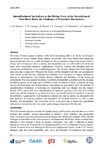Intensification of Agriculture as the Driving Force in the Degradation of Nzoia River Basin: the Challenges of Watershed Management

View/
Date
2007Author
Onywere, S. M.
Getenga, Zachary
Baraza, W
Twesigye, C.K.
Mwakalila, S.S.
Nakiranda, J. K.
Metadata
Show full item recordAbstract
The Lake Victoria riparian countries suffer from devastating effects of floods and droughts
occasioned by severe weather related natural phenomena. The floods often follow prolonged
droughts that have become a mark of despair for the communities living in the region. Climate
change and anthropogenic factors causing land degradation such as deforestation of catchment
areas, poor agricultural practices, inappropriate livelihood systems and changing land use
systems are established to be the contributing factors. The physical setting of the flood impacted
areas also play a major role. Whenever the floods and the droughts occur they are accompanied
with serious human distress, suffering and fatalities with disruption of human settlements,
damage to infrastructure, crop failure, disease outbreaks and disruption of the ecological
environment. Two case studies illustrating the effects of intensified agriculture and the changing
livelihood systems at the upper part of Middle Nzoia Catchment at Nzoia sugarcane growing
area and the flood plain area of Nzoia River at Budalangi are presented to show the potential of
geoinformation technology in assessing and monitoring land use changes and the impacts
therein. SPOT image data show intensification of sugarcane growing with every inch of land
under crop. All the wetlands along Nzoia river have been drained up to the riverbank. Although
the problem is aggravated by rapid population increase the land use policy has disregarded the
land potential, its carrying capacity, and limitations of the land resources as well as their
diversity and distribution. The conversion of the land cover into a mono-crop agricultural
cultivation is evident from the time series Landsat image interpretation for the area.
